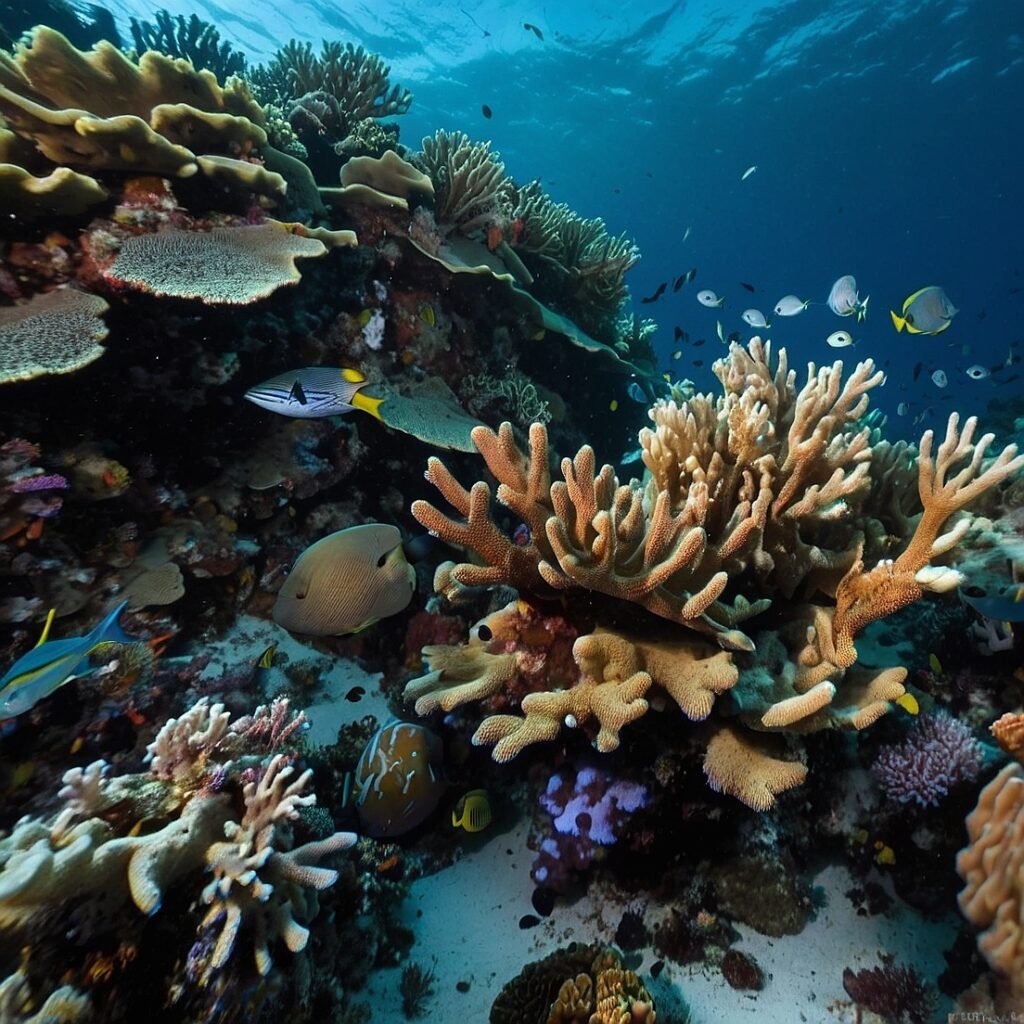Have you ever dreamed of exploring an underwater paradise teeming with vibrant marine life and pristine coral reefs? Look no further than Tubbataha Reef, a true gem nestled in the heart of the Coral Triangle. This spectacular natural wonder, located in the Sulu Sea of the Philippines, is not just a diver’s dream come true—it’s a vital ecosystem that plays a crucial role in maintaining the health of our oceans. Join me as we dive deep into the fascinating world of Tubbataha Reef, uncovering its rich biodiversity, conservation efforts, and the unforgettable experiences it offers to those lucky enough to visit.
A Natural Wonder in the Heart of the Sulu Sea
Location and Geography
Tubbataha Reef lies in the middle of the Sulu Sea, about 150 kilometers southeast of Puerto Princesa City in Palawan, Philippines. This remote marine sanctuary is actually composed of two huge atolls—the North and South Atolls—and a smaller reef called Jessie Beazley Reef. Together, they cover an area of nearly 100,000 hectares, making Tubbataha one of the largest marine protected areas in the Philippines. The isolation of these reefs has been a blessing in disguise, as it has helped preserve their pristine condition and incredible biodiversity.
Formation and Geological Significance
The story of Tubbataha Reef’s formation is as fascinating as the reef itself. These atolls began their journey millions of years ago as volcanic islands. Over time, as the volcanoes became extinct and the islands slowly sank, coral reefs grew around their edges. This gradual process eventually led to the formation of the stunning atolls we see today. The geological significance of Tubbataha extends beyond its beauty—it provides scientists with valuable insights into the formation and evolution of coral reef ecosystems in the Philippines and the wider Indo-Pacific region.
A Biodiversity Hotspot Like No Other
Marine Life Abundance
Prepare to be amazed by the sheer abundance and diversity of marine life at Tubbataha Reef. This underwater wonderland is home to an astounding array of species, many of which are found nowhere else on Earth. With over 600 species of fish, 360 species of corals, 11 species of sharks, and 13 species of dolphins and whales, Tubbataha is a living testament to the incredible biodiversity of our oceans. From the tiniest nudibranchs to massive whale sharks, every dive here promises an encounter with something extraordinary.
Endangered Species and Their Habitats
Tubbataha Reef isn’t just a haven for common marine species—it’s also a crucial sanctuary for many endangered and threatened animals. The reef provides vital nesting grounds for hawksbill and green sea turtles, both of which are critically endangered. It’s also one of the few places in the world where you might spot the elusive megamouth shark or the majestic Napoleon wrasse. The presence of these rare creatures underscores the importance of Tubbataha as a biodiversity hotspot and highlights the urgent need for its continued protection.
UNESCO World Heritage Site Status
Recognition and Significance
In 1993, Tubbataha Reef received the prestigious designation of UNESCO World Heritage Site, cementing its place among the world’s most extraordinary natural wonders. This recognition came as a result of the reef’s outstanding universal value, pristine condition, and crucial role in the marine ecosystem of the Sulu Sea. The UNESCO status has not only brought international attention to Tubbataha but has also provided additional support for conservation efforts and sustainable management practices.
Criteria for Inclusion
Tubbataha Reef met several criteria for inclusion as a World Heritage Site. Its exceptional natural beauty, geological significance, and importance as a habitat for threatened species were all factors in its selection. Additionally, the reef’s role in supporting a wide diversity of marine life and its importance to the broader ecosystem of the Coral Triangle were recognized. This designation has been instrumental in raising awareness about the reef’s importance and attracting support for its preservation.
The Coral Triangle Connection
Understanding the Coral Triangle
Tubbataha Reef is a vital part of the Coral Triangle, often referred to as the “Amazon of the Seas.” This vast marine region, spanning six countries in the Indo-Pacific, is the global center of marine biodiversity. The Coral Triangle is home to 76% of the world’s coral species and more than 2,000 species of reef fish. Tubbataha’s location within this biodiversity hotspot makes it an essential piece of the puzzle in understanding and preserving marine ecosystems on a global scale.
Tubbataha’s Role in the Ecosystem
As a key component of the Coral Triangle, Tubbataha Reef plays a crucial role in maintaining the health and balance of marine ecosystems throughout the region. The reef acts as a source of larvae for fish and coral species, helping to replenish and sustain other reef systems in the Sulu Sea and beyond. Its pristine condition also makes it an invaluable reference point for scientists studying the impacts of climate change and human activities on coral reefs, providing insights that can inform conservation efforts worldwide.
Conservation Efforts and Challenges
Management and Protection Measures
Preserving Tubbataha Reef’s pristine beauty and rich biodiversity is no small feat. The Tubbataha Management Office, in collaboration with various government agencies and NGOs, works tirelessly to protect this marine wonder. Their efforts include strict regulation of tourism activities, regular patrols to prevent illegal fishing, and ongoing research and monitoring programs. The establishment of a no-take zone within the park boundaries has been particularly effective in allowing marine life to thrive undisturbed.
Threats to the Reef
Despite its remote location and protected status, Tubbataha Reef faces numerous challenges. Climate change poses a significant threat, with rising sea temperatures leading to coral bleaching events. Illegal fishing, though greatly reduced, remains a concern, as does marine pollution from passing ships. The increasing frequency of severe storms in the region also poses a risk to the delicate coral structures. Addressing these challenges requires ongoing vigilance, innovative solutions, and international cooperation.
Diving into Adventure: Exploring Tubbataha
Planning Your Visit
Ready to experience the wonder of Tubbataha Reef firsthand? Planning your trip requires some forethought, as the park is only open to visitors from mid-March to mid-June when sea conditions are most favorable. Access to the reef is exclusively by liveaboard boats, which typically depart from Puerto Princesa City. These multi-day diving expeditions offer the chance to fully immerse yourself in the Tubbataha experience, with multiple dives each day and the opportunity to explore different areas of the vast marine park.
Dive Sites and Highlights
Tubbataha boasts some of the most spectacular dive sites in the world, each offering unique experiences and marine life encounters. The Malayan Wreck, located on the North Atoll, is a favorite among divers for its dramatic wall dives and the chance to spot large pelagic species. The Amos Rock site is known for its incredible biodiversity, featuring everything from tiny nudibranchs to massive Napoleon wrasses. For those seeking an adrenaline rush, the Shark Airport area often delivers with sightings of reef sharks and sometimes even tiger sharks or hammerheads.
The Cultural Significance of Tubbataha
Local Communities and Traditional Knowledge
While Tubbataha Reef itself is uninhabited, it holds great cultural significance for the people of Palawan and the broader Philippines. Local communities, particularly the indigenous Tagbanua people, have long-standing connections to these waters, with traditional knowledge passed down through generations. This cultural heritage includes navigational techniques, fishing practices, and a deep respect for the marine environment. Integrating this traditional knowledge with modern conservation approaches has been crucial in developing effective management strategies for the reef.
Legends and Folklore
The name “Tubbataha” itself is steeped in local lore, believed to be derived from the Samal language meaning “long reef exposed at low tide.” Legends surrounding the reef speak of its mystical origins and the spirits that are said to protect it. These stories not only add to the allure of Tubbataha but also reflect the deep connection between the local people and their marine environment. Preserving these cultural narratives alongside the physical reef is an important aspect of Tubbataha’s overall conservation efforts.
Scientific Research and Discoveries
Ongoing Studies and Monitoring
Tubbataha Reef serves as a natural laboratory for marine scientists from around the world. Ongoing research projects cover a wide range of topics, from coral resilience to the impacts of climate change on reef ecosystems. Regular monitoring programs track the health of coral populations, fish abundance, and the presence of indicator species. These studies not only contribute to our understanding of Tubbataha but also provide valuable insights into the broader health of coral reefs globally.
Recent Discoveries
The rich biodiversity of Tubbataha continues to surprise researchers, with new species discoveries being made regularly. In recent years, scientists have identified several new species of nudibranchs and other marine invertebrates previously unknown to science. These discoveries highlight the importance of Tubbataha as a reservoir of marine biodiversity and underscore the potential for further scientific breakthroughs in this remarkable ecosystem.
Sustainable Tourism and Its Impact
Balancing Conservation and Visitation
Tubbataha Reef faces the challenge of balancing conservation with the desire to share its beauty with visitors. The park’s management has implemented a strict carrying capacity limit, allowing only a certain number of dive boats and visitors each season. This approach helps minimize the impact on the fragile ecosystem while still providing opportunities for people to experience the reef’s wonders. Sustainable tourism practices, such as proper waste management and responsible diving guidelines, are rigorously enforced to ensure that tourism benefits rather than harms the reef.
Economic Benefits for Local Communities
While direct access to Tubbataha is limited, the reef’s existence provides significant economic benefits to the surrounding region. The dive tourism industry in Palawan has flourished, creating jobs and income opportunities for local communities. Additionally, the success of Tubbataha as a marine protected area has inspired similar conservation efforts in other parts of the Philippines, further contributing to the growth of sustainable eco-tourism throughout the country.
Climate Change and Tubbataha’s Future
Observed Impacts and Adaptation
Like coral reefs worldwide, Tubbataha is feeling the effects of climate change. Rising sea temperatures have led to instances of coral bleaching, while increasingly severe storms pose a threat to the reef’s physical structure. However, Tubbataha has shown remarkable resilience thus far. Its remote location and protected status have allowed it to recover more quickly from bleaching events compared to many other reefs. Scientists are closely studying Tubbataha’s adaptation mechanisms, hoping to apply these insights to coral conservation efforts globally.
Future Projections and Conservation Strategies
Looking ahead, the future of Tubbataha Reef in the face of climate change remains uncertain. Conservation strategies are evolving to address these challenges, including the exploration of coral restoration techniques and the identification of climate-resistant coral species. Efforts are also underway to reduce other stressors on the reef, such as pollution and overfishing, to enhance its overall resilience. The ongoing protection and study of Tubbataha may hold the key to understanding how coral reefs can survive and thrive in a changing world.
How You Can Help Protect Tubbataha
Responsible Tourism Practices
If you’re planning a visit to Tubbataha Reef, there are several ways you can contribute to its conservation. Choose tour operators that adhere to sustainable practices and respect park regulations. When diving, maintain proper buoyancy control to avoid damaging corals, and resist the temptation to touch or collect anything from the reef. Be mindful of your waste and ensure that nothing is left behind. By being a responsible visitor, you’re helping to preserve Tubbataha for future generations to enjoy.
Supporting Conservation Efforts
Even if you can’t visit Tubbataha in person, there are still ways to support its protection. Consider donating to organizations involved in Tubbataha’s conservation, such as the Tubbataha Management Office or WWF-Philippines. Spread awareness about the importance of Tubbataha and other marine protected areas through social media and your personal networks. Every action, no matter how small, contributes to the collective effort of preserving this underwater paradise.
A Treasure Worth Protecting
Tubbataha Reef stands as a shining example of what’s possible when we commit to protecting our natural wonders. Its pristine beauty, incredible biodiversity, and resilience in the face of global challenges make it a true treasure of our planet. As we’ve explored in this blog, Tubbataha is more than just a stunning dive destination—it’s a vital ecosystem, a living laboratory, and a beacon of hope for marine conservation worldwide.
Whether you’re a passionate diver, a marine biology enthusiast, or simply someone who cares about the health of our oceans, Tubbataha Reef offers inspiration and valuable lessons. It reminds us of the extraordinary beauty that exists beneath the waves and the urgent need to protect these fragile ecosystems. As we face the challenges of climate change and environmental degradation, places like Tubbataha become even more crucial—not just for their intrinsic value, but for the hope and knowledge they offer for the future of our oceans.
So, let’s celebrate Tubbataha Reef, spread the word about its importance, and do our part to ensure that this UNESCO World Heritage Site continues to thrive for generations to come. Who knows? Maybe one day you’ll find yourself diving in its crystal-clear waters, marveling at the underwater spectacle that is Tubbataha Reef. Until then, let’s work together to keep this marine paradise protected and pristine.
Disclaimer: While every effort has been made to ensure the accuracy of the information presented in this blog, marine ecosystems are dynamic and constantly changing. Some details may have evolved since the time of writing. We encourage readers to consult the most up-to-date scientific literature and official sources for the latest information on Tubbataha Reef. If you notice any inaccuracies, please report them so we can promptly make corrections.




